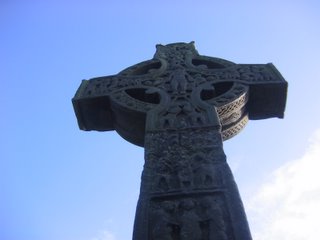High Crosses

This is the eleventh century high cross at Drumcliffe in County Sligo. It stands on the site of sixth century monastic settlement, of which nothing remains but the ruins of round tower. Drumcliffe is also the final resting place of W. B. Yeats.

A close-up of some of the so-called Celtic knot design on one of the sides of the cross.

One of the three magnificent tenth century high crosses at Monasterboice in County Louth, not far from Dublin. These are said to be among the finest examples of high crosses, and I will certainly concur to their beauty and magnificence. Monasterboice, as one may deduce from the name, was once a monastic site, and boasts, in addition to the crosses, a fine round tower, albiet missing its cap. The site, which also has the ruins of churches that were built after the monastery went defunct, is in the midst of gentle rolling countryside, not far from Newgrange, the Hill of Slane, the Hill of Tara, and other famous sites.

Another of the high crosses, with the round tower in the background. These towers functioned primarily as bell-towers; in addition they probably function as repositories for valuables, and possibly for defense, though this is disputed.

The simplest of the high crosses at Monasterboice.













0 Comments:
Post a Comment
<< Home